
From mid-May to late-July, Liz and I have been driving to far-eastern Canada and back in hopes of visiting friends and family, seeing much of North America for the first time, and spotting a bunch of new birds. We drove north out of Michigan into Quebec, then east and north to Labrador City and Goose Bay, then to Cartwright, Labrador, the northeastern-most city serviced by road in North America. From there, we drove south across Labrador and Newfoundland. What wonderful places full of wild country and wonderful people; when you live on the edge, you learn to celebrate life. From there we've been visiting Nova Scotia and New Brunswick, and we'll eventually get down into New England before returning home. Google said it would take 70 hours of driving time to get from Las Vegas to Cartwright, but for us, that was a big underestimate -- and out schedule keep slipping. Our day-to-day adventures are summarized below and on linked pages. Link to trip map.
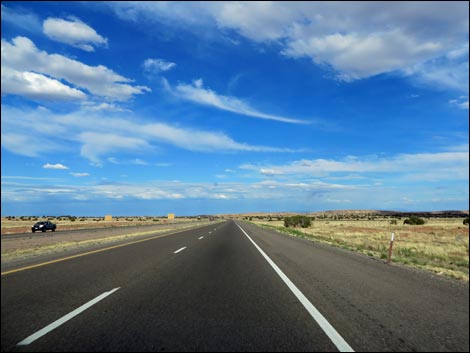 Long, Lonesome highway in New Mexico |
Day 01. May 22, 2014. Wednesday. Las Vegas, NV, to Albuquerque, NM (Drive time 9 hrs) Long but uneventful drive from Home to ABQ. We got out of the house about 7:30 AM and out of town about 8:30 AM. Nobody tried to crash into us on the highway, and the clouds and a bit of rain kept the day cool. We arrived in ABQ about 6:30 PM. |
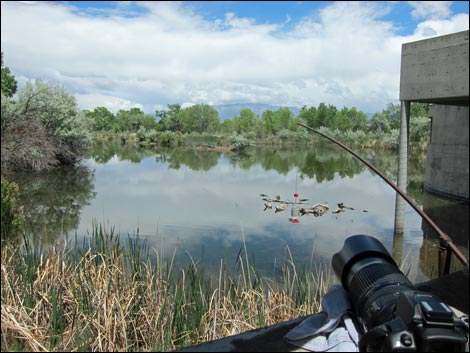 Rio Grande Nature Center |
Day 02. May 23, 2014. Friday. Albuquerque Lots of running around town being busy and having fun, with the highlight being a stop at the Rio Grande Nature Center. We saw about 30 species of birds (including Greater Roadrunner, Summer Tanager, and lots of Black-chinned Hummingbirds), three species of turtles, and some pretty dragonflies. Between rain showers we went outside and birded under towering cottonwood trees, but otherwise the indoor viewing area was perfect for the day. |
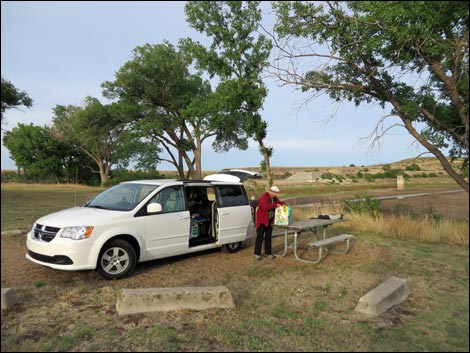 McClellan Creek National Grasslands |
Day 03. May 24, 2014. Saturday. Albuquerque to McClellan Creek National Grasslands, TX (Drive time 6 hrs) We drove east from Albuquerque, stopping at a couple of roadside rest areas that turned out to be pretty good birding. The first was full of Western Kingbirds, Say's Phoebes, and Bullock's Orioles, and the second was full of Scissor-tailed Flycatchers. Unfortunately, we saw a Chihuahuan Raven take a nestling and go feed it to it's own nestlings. We spent the night camped at McClellan Creek National Grasslands, which also turned out to be a fantastic place to bird. The Grasslands area has two campgrounds, one of which is for ATVs; we stayed at the other one. |
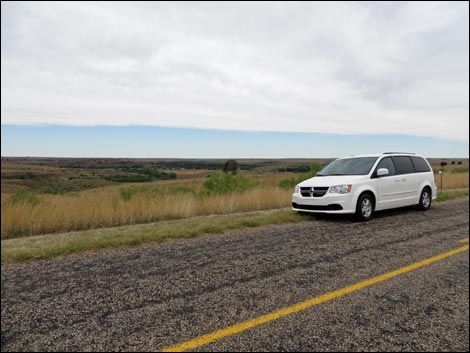 West Texas roadside |
Day 04. May 25, 2014. Sunday. McClellan Creek to Perkins, OK Continuing east after a leisurely breakfast with the birds, we drove pretty hard to Perkins to visit with friends. We rolled in during the afternoon rain shower, then walked the property looking at birds and projects (old cars and lots of car parts). Stu Preston (AGT Motors) restores historic vehicles. |
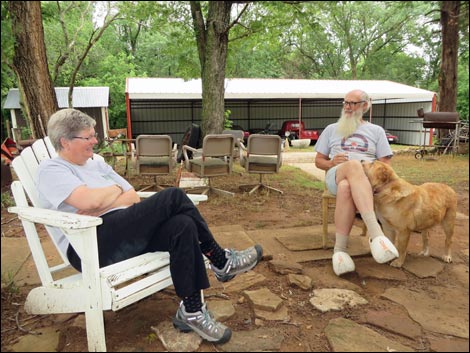 Relaxing in Perkins |
Day 05. May 26, 2014. Monday. Perkins We decided that for the remainder of Memorial Day weekend, we would stay off the roads. We spent the day with friends touring the local area, visiting Oklahoma State University campus, running errands, eating good food, and sharing good company. |
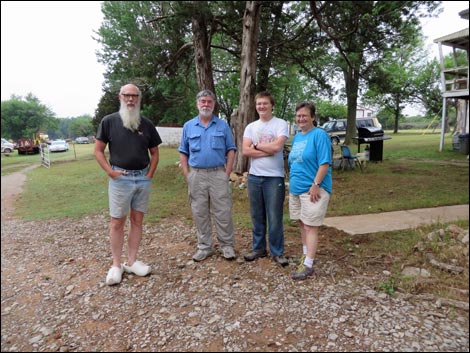 Departing Perkins |
Day 06. May 27, 2014. Tuesday. Perkins to St. Louis, MO After a couple of cups of coffee on the porch with the birds, dogs, and friends, we loaded up and drove pretty hard to St. Louis. We got a room not far from the Missouri Botanical Gardens and places where we might find Eurasian Tree Sparrows. The road was long and wet today, making a dip in the motel pool particularly refreshing. |
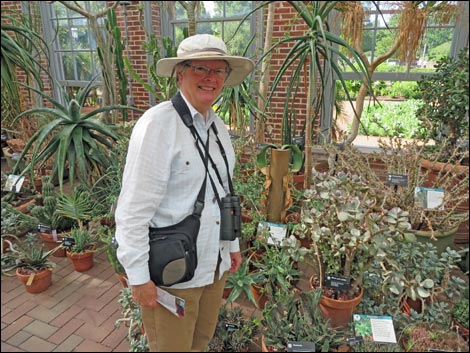 Liz inside the oldest continuously operating greenhouse in America |
Day 07. May 28, 2014. Wednesday. St. Louis to Ft. Wayne, IN Early in the morning, we went to an urban park where Eurasian Tree Sparrows were recently reported. These sparrows only occur reliably around St. Louis, so if you are a birder, you need to make the pilgrimage to St. Louis. Sure enough, we saw several right away and got some good photos. This was the first Life Bird (LB#614) of the trip, and so being a non-native species, opens the count on a low note. So far, we've seen about 100 species total. From there, we went to the Missouri Botanical Gardens, which are world famous in botany circles for the scientific research they have done since the mid-1800s. We spent several hours there, had lunch inside, and then departed St. Louis for places east and north. We crossed the Mississippi River, passed through Indianapolis, Illinois, and turned north, making it as far as Ft. Wayne, Indiana. |
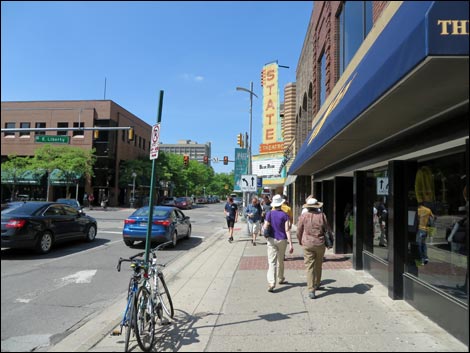 Kathy (L) and Liz (R) on walking tour of downtown Ann Arbor |
Day 08. May 29, 2014. Thursday. Ft. Wayne to Ann Arbor, MI Up and out fairly early, we drove about 3 hours to Ann Arbor where we met Liz's old boss, Kathy, from the University of Georgia. It has been some twenty years since we last saw her, and she is as lively as ever. After a nice lunch in a cafe adjacent to the university, Kathy took us on a walking tour of her campus area, including an excursion to the Nichols Arboretum Peony Garden (blooming a little late this year), a walk along the N. Huron River (lots of leafy trees, few birds, one garter snake), and a visit to her lab in the medical building. Kathy then took us on a driving and walking tour of downtown Ann Arbor, dropped us off at her house with washing machine instructions, and headed to Detroit to sing for the evening. With clean clothes, we look forward to seeing her for breakfast in the morning. |
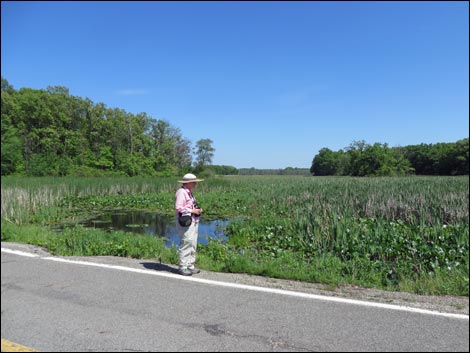 Birding a marsh at Waterloo State Recreation Area |
Day 09. May 30, 2014. Friday. Ann Arbor to Jackson, MI We walked downtown and had breakfast at Zingerman's, a nice deli with tasty high-end food. From there, we went to Best Buy to pick up a charger for a camera battery that we left at home. They didn't stock the low-end unit, so the lesson cost us $40. We then drove some 30 minutes west of Ann Arbor to Waterloo State Recreation Area with high hopes for lots of birds. The area is mostly hardwood forest with several lakes and lots of marshy areas. We saw two life birds (Cerulean Warbler [LB#615] and Black-billed Cuckoo [LB#616]), plus several other interesting species (Veery, Indigo Bunting, Eastern Towhee, Red-eyed Vireo, Bank Swallow, and Eastern Wood Peewee). We also saw Sandhill Cranes and Eastern Chipmunks. With a high of 80 degrees, the day was much hotter than we expected, but at least it was sunny and dry. We stayed in a noisy campground (turns out to be only an hour from Detroit on a Friday night) with lots of mosquitoes, but the night was nice and cool with tons of frogs calling. |
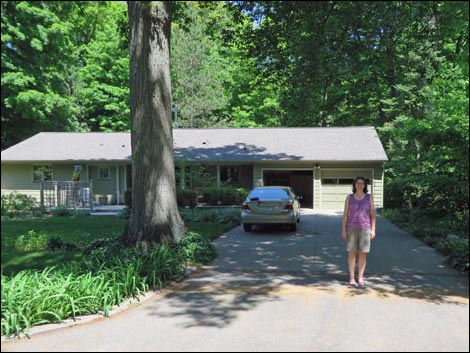 Kate in Lansing, Michigan |
Day 10. May 31, 2014. Saturday. Jackson to Grayling, MI In spite of our concerns, the campground quieted quickly after sunset, and we got up and out of the campground early. We birded a couple of new Waterloo State Recreation Area sites and saw some trip-birds, including Baltimore Oriole, Gray Catbird, Red-breasted Nuthatch, and a big fat Woodchuck. We then headed north to Lansing to visit old friends from the Yucca Mountain era. We saw Kate for lunch, then went across town to visit Pat in the afternoon. The two seem to be doing well, and their girls are grown and successful, but we were disappointed that they split up last year. Pat told us of some birding places to check on our way farther north, so we stopped at a marsh and saw Black Terns, Wilson's Snipe, and two Osprey on a nest. Finishing the day looking for Kirtland's Warblers after sunset and not finding them, we got a motel room out of the hordes of bugs and prepared for tomorrow. |
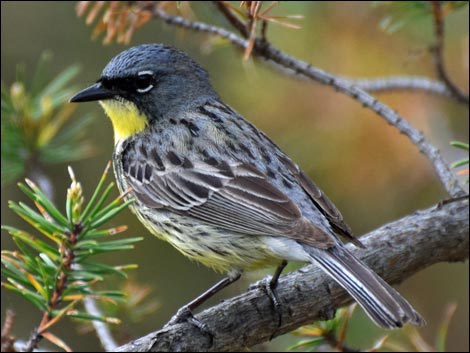 Most rare warbler in North America: Kirtland's Warbler (male) |
Day 11. June 01, 2014. Sunday. Grayling Up and out early, we arrived at the Kirtland's Warbler site not long after sunrise. We walked the perimeter roads for most of an hour, hearing, we think, one or two singing males. Then, about a dozen cars pulled up and a hoard of birders got out -- an Audubon outing! We tagged along and were treated to the most amazing, close-up views of male and female (usually hard to find because they don't sing) Kirtland's Warblers (LB#617), plus a nest! We also saw Connecticut Warbler (LB#618), Palm Warbler, Upland Sandpiper, Nashville Warbler, and Clay-colored Sparrow. Oops, forgot Alder Flycatcher (LB#621). We had so much fun that we decided to say another night in Grayling. In the afternoon we went looking, without luck, for a Snowy Owl that the Audubon group saw earlier, and later walked in a state park that was full of Rose-breasted Grosbeaks, Evening Grosbeaks, Eastern Chipmunks, and Red Squirrels. |
 Liz with her plants at Wilderness State Park, Michigan |
Day 12. June 02, 2014. Monday. Grayling to Saginaw City, MI We went back to the Kirtland's Warbler site early and had a nice walk with the the warblers. This time, however, we realized just how lucky we were yesterday with close-up views. We then drive north to Wilderness State Park where we walked in the woods for a couple of hours. We saw a few giant patches of dwarf iris in bloom. Just as we were leaving, a huge rainstorm came up and we sat in the van watching the squalls over Lake Michigan for some time. The rain eventually let up, and we drove into Saginaw City where we got a room for the night. |
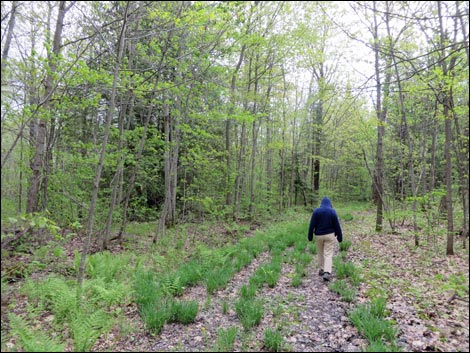 Walking in the woods, Ontario, Canada |
Day 13. June 03, 2014. Tuesday. Saginaw City to Killarney, Ontario, Canada We drove across the Mackinac Bridge into the Upper Peninsula of Michigan amid rain showers. We drove straight up to Sault Ste. Marie and visited the locks under cloudy skies and wet pavement. After a bit, we crossed into Canada without incident, then drove east to Killarney. We stopped a couple of times to look for birds and stretch our legs, visited Killarney Provincial Park briefly (they wanted $42.09 to camp with the rain and bugs!), then drove to the end of the road at Killarney, proper, and got a room for the night at The Pines Inn (a delightful B&B). It was a long day on the road, and the room was expensive, but not so compared to the camping fee. We enjoyed a nice dinner, walked around town (which is to say, along the waterfront, and retired to our room. The day ended clear, but with a strong, cold wind. |
 Lighthouse near Killarney, Ontario, on glacier-polished granite |
Day 14. June 04, 2014. Wednesday. Killarney to Ottawa, ON After sleeping in and eating a late, slow breakfast with the owner of the B&B, we headed over to the lighthouse. Amid a plethora of bugs, we caught a Painted Turtle and saw a male Blackburnian Warbler, Black-and-White Warbler, Red-eyed Vireo, and a flock of Cedar Waxwings actually in a cedar tree eating cedar berries. It was interesting to see life on a large, ocean-like lake. Life in Killarney hearkened back to settlement days and a simpler way of life. Although the day started out clear, most of it was cloudy and everywhere we stopped was full of bugs and nearly devoid of birds. We drove a bit farther than we expected, stopping for the night on the east side of Ottawa -- at least we are past the morning rush-hour traffic. Driving through Ottawa was surprisingly like driving through any big American city - I guess I was disappointed, although I don't know what I expected. |
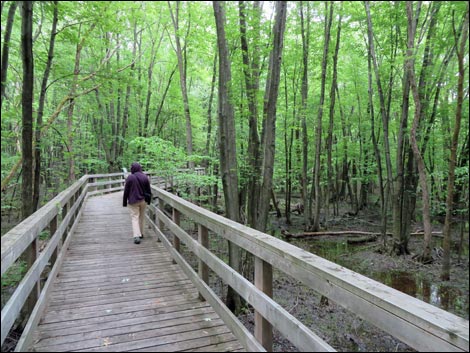 Delightful boardwalk in wet forest near Louiseville |
Day 15. June 05, 2014. Thursday. Ottawa to Boischatel, Quebec Checking out of our $150/night hotel on the outskirts of Ottawa, we decided that it offered little value over our usual $40/night hotel routine. This area is expensive, but that was ridiculous, plus they all speak French (which isn't so hard to deal with). Driving west, we stopped at a great birding spot: the Alfred Sewage Treatment Lagoon. We saw lots of ducks, our first grebe of the trip, White-rumped Sandpiper, Bobolink, and Hudsonian Godwit. Continuing east, we stopped at a roadside rest information center and learned about a nearby birding area. We found a delightful boardwalk through wet forest near Louiseville, QC, on the banks of the St. Lawrence River. The birding wasn't superb, but we had a nice walk and saw some fun birds (Eastern Phoebe, Belted Kingfisher, and Magnolia Warbler). Best of all, the bugs were barely noticeable. We then drove through downtown Quebec City and out to an Economy Inn just east of the city. Economy up here is $100. At least it includes breakfast. Out back of the hotel, we got our first view of tide-flats along the St. Lawrence River. |
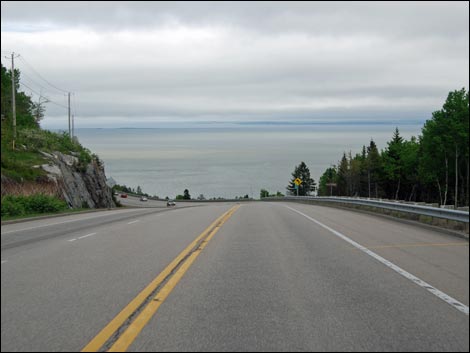 Highway winding among mountain cliffs and St. Lawrence River |
Day 16. June 06, 2014. Friday. Boischatel to Les Escoumins, QC We were up and out fairly early on a cloudy morning to bird at Cap Tourmente National Wildlife Area. The birding was pretty good for some things (Alder, Least, and Olive-sided flycatcher, Blackpoll Warbler, Swamp Sparrow), but not so good for others (we expected lots of ducks and shorebirds but saw almost none). We had enough fun to stay until 1 PM. We got a bit of rain at Cap Tourmente and on-and-off all day as we drove along the St. Lawrence River; we even got some 25-mph-fog along the highway. A bit scary at the speeds they drive here. We stopped when we could at towns and natural areas along the way. One stop that we almost skipped because it was getting late produced Black Guillemots (LB#619), Common Eider (LB#620), Great Black-backed Gull, and Black-legged Kittiwake! We are finding that our lack of skill in the French language is both fascinating and frustrating. We are having fun puzzling out meanings, and we are meeting many nice Quebec'ers happy to practice their English, but some of the highway warning signs just leave us baffled. |
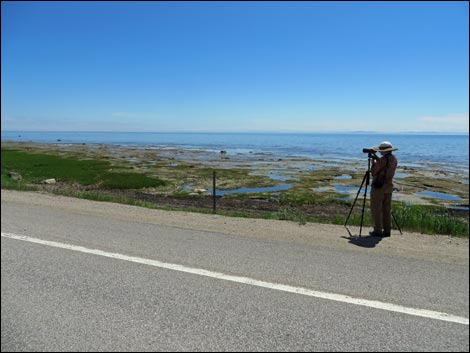 Birding from the highway along the St. Lawrence Seaway |
Day 17. June 07, 2014. Saturday. Les Escoumins to Baie-Comeau, QC We started the day with a delightful breakfast in a little boulangerie (bakery) next to the hotel, then birded the points on both sides of the harbor. We were treated to more Eiders, Kittiwakes, and Black Ducks, plus Long-tailed Ducks and Barrow's Goldeneye. Heading northeast along the St. Lawrence Seaway, we stopped at several places where the road runs along the coast, plus some scenic stops where rivers pour over falls into the sea. At Quai de Ragueneau, we pulled off at a likely spot and found a bunch of dinosaur figures (standing to about 10-ft tall) for what reason we know not. However, the birding was pretty good with probable Thick-billed Murre and Arctic Tern, plus more Eiders with chicks. At another spot, we saw two Black Brants. We finally arrived at Baie-Comeau in the afternoon. This turns out to be a big industrial town with little to entice tourists. We did, however, find a nice hotel for the night before heading north towards Labrador City. We have no knowledge, no plans, and no expectations, but we do want to find boreal birds. |
 Birding over a beaver pond in the Great Northern Forest |
Day 18. June 08, 2014. Sunday. Baie-Comeau north into Wildlands, QC After checking out of our fine hotel and a most civilized breakfast at McDonald's-Canada, we topped off the gas tank, checked the oil, and turned north on Highway 389 towards Labrador City, heading into the vast and largely unpopulated north. We had nothing to do but drive and watch birds, so we stopped many times during the day. Some stops were pretty quiet, but none were worthless. At an early stop, Liz caught a toad, but then we were surprised by two black bears. Towards the end of the day, we encountered a forest fire. We saw no ground crews, but two air-tanker bombers were working hard. We stopped to watch the planes, and one laid a line of water right next to the van, and the drift actually wet the car! We did some 250 miles today, passing the 4,000-mile-mark about mid-morning, and stopped for the night near mile-post (kilometer) 350 in what passes for a roadside rest area. |
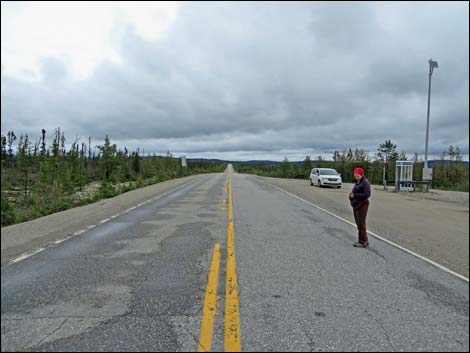 Finding Gray Jays along Highway 389 in eastern Quebec |
Day 19. June 09, 2014. Monday. The Northwoods, QC, to Labrador City, Labrador Lesson for the day: In the far north, when the north wind comes calling, you need to pay attention. Camping out, we awoke at dawn, about 3:30 AM, and again at about 4:30, to a wonderful red sunrise. We thought about getting up, but slept a bit more and awoke to the sound of rain as the day opened wet and cold. At least the bugs were too cold to bite. We spent the day driving north and stopping to look and listen for birds. We encountered another 70 km of dirt road, this time rougher than before and traversing an industrial landscape torn up and shuffled about in search of timber and minerals. The influx of highly-paid workers in many remote areas is increasing the cost of rooms. We eventually made it into the province of Labrador where it was cold and overcast but dry. We got a room and went up on a local mountain to a ski area (only a little snow remains) and did some hiking. The woods were quiet, but it was a treat to walk in wet woods full of Red Squirrels and lots of moss. |
 Walking among spruce trees with lots of moss and lichens |
Day 20. June 10, 2014. Tuesday. Labrador City to east of Churchill, Labrador Today we rode again with the cold north wind. The day was mostly sunny, but the day topped out at 52 degrees with a stiff breeze that bit hard on our Nevada-warm-and-tender behinds. Birding in the woods was difficult, as bird calls were muffled by wind and bird movements were obscured by dancing trees. Birding the lakes and marshes was a bust. Even so, we had a delightful day hiking here and there without the benefit of biting insects. We did several short hikes and one longer hike, which was on a real trail to a waterfall on the Churchill River that would be a world-class attraction in a more accessible part of the world. To our disappointment, we can confirm that information provided on a Canadian government website is not correct: the entire Trans-Labrador Highway is not paved. They are working on it, but we may yet have hundreds of miles of gravel road. [read more] |
 Jim walking on carpets of reindeer moss in the wild north woods |
Day 21. June 11, 2014. East of Churchill to Goose Bay, to a Wilderness Campsite, Labrador Feeling like we needed a lay-over day, we turned off the 6:30 alarm and slept until 8:30. The morning was crisp and partly cloudy with the north wind pushing just enough to keep the bugs away -- overall a delightful start to the day. It turns out that the gravel road was relatively short, on a few dozen miles. We fixed breakfast and hiked in the woods and along the river at camp, then continued east on the gravel road. To our delight, we found pavement again. We stopped several times before the rain started, then drove the last 100 kilometers into the big little city of Happy Valley-Goose Bay without stopping. In Goose Bay, we ate an early dinner, bought groceries, did Internet stuff, got an oil change, washed laundry, and topped off the gas tank. Loaded for the wilds, we started southeast on Highway 510 anticipating several hundred miles of gravel roads and more nights of camping in wild places. Tonight we stopped in a parking area (what passes for a roadside rest area) on the banks of the Kenamu River. This is such an amazing place, and with the night growing dark at 10:30 pm, we are shutting down and going to bed. |
 Lunch along the Labrador Coastal Highway |
Day 22. June 12, 2014. Campsite to Cartwright, Labrador We departed the Kenamu River about 9 AM heading east. As we have become accustomed, we stopped lots of times to listen to the silent woods. Today, however, our luck changed and the boreal birds started singing. We saw Boreal Chickadee (LB#622), Common Redpoll (LB#623), and heard Gray-cheeked Thrush (LB#624) singing. We also think we heard a Boreal Owl calling, although that would be unusual in the daytime. We saw a Solitary Sandpiper standing atop a spruce tree in its breeding habitat, a male Merlin, and a Surf Scoter in its breeding habitat (not near the surf). Perhaps the best boreal species we saw, however, was Woodland Caribou! We saw a female and her calf not far from the highway. They posed nicely for lots of photos. To top it off, we saw three black bears today. By evening, we arrived in Cartwright, arguably the turn-around point on our trip. We are at the northeastern-most point serviced by road in North America, and we've driven some 4,800 miles to get here. We even got the last available room in town (#5 of 5). The weather now is cold and windy; when it warms up the bugs will be hungry! |
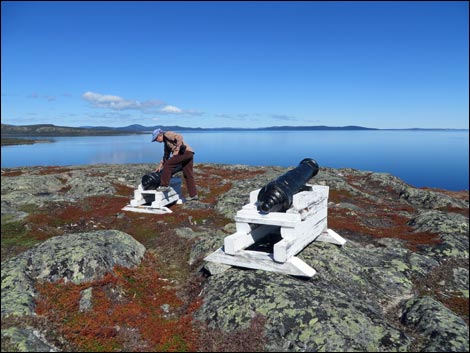 1770-era cannons still guarding the entrance to Cartwright Harbor |
Day 23. June 13, 2014. Cartwright to Port Hope-Simpson, Labrador We birded Cartwright in the morning, with the highpoint being a hike up a hill to a cannon battery that was set up to protect Cartwright Harbor from American Privateers (pirates) in the late 1770s. The wooden mounts are replicas; the cannons are real. In the harbor, we saw Glaucous Gulls, Great Black-backed Gulls, Herring Gulls, and Ring-billed Gulls, plus Common Eider and Common Murre. Then in the woods, we learned that Northern Waterthrush (normally a ground bird) sings its loud song from the tips of tall trees! From there, we headed south towards Newfoundland. We didn't make it - not even close. Our plans for the day were thwarted by a damaged tire (hundreds of miles on dirt roads do that). We limped into town on the spare "donut" tire, and were able to get a new tire that was about the size of the original. As they say up here, you learn to do without a lot of things you want, and you pay a lot for the things you get. At any rate, the tire shop serves soft-serve ice cream, so all is not lost, plus we get to spend the night in a town we expected to drive on through. |
 Holy cow -- icebergs in St. Lewis |
Day 24. June 14, 2014. Port Hope-Simpson to Mary's Harbour, Labrador Today was not a good day for birding. The weather was grand and a few birds were singing, but this was a day for visiting cultural sites, hiking, and watching icebergs. It was also a good day for mammals (moose momma and calf, red fox posing for photos, and snowshoe hare) and boreal toads. St. Lewis, the eastern-most town on North America, is known for icebergs, but because of the hard winter, the sea ice has not fully cleared out. We were treated to the most amazing sight when we crested a hill and the ocean was jumbled white for as far as we could see (which was a few hundred yards into the fog). During the day, the tide and winds carried much of the "drift ice" into St. Lewis Bay, choking the harbor and preventing boats from going in or out. We ended the day hiking at Mary's Harbour and got a room. The kitchen was long closed by 9 PM, but they made us soup and sandwiches. The people up here are so nice. [read more] |
 Our hotel room on Red Bay |
Day 25. June 15, 2014. Mary's Harbour to Red Bay, Labrador Heading south, we drove around Lodge Bay and saw what we think were two Yellow-crowned Night-Herons, a bit north of where they should be. Continuing, we were blocked by road construction. They were doing some blasting, so we spent about an hour chatting with locals and enjoying the grand scenery. If you get stuck in construction, there isn't a better place in the world to do it. We made it to Red Bay and the end of unpaved roads. We stopped at the local museum to learn about the Basque Whaling history (dating from about 1540 to the early 1600s) and were waylaid by staff regaling us with unending stories of local history. When they learned we were birders, we had a very long discussion about the taste of various local birds. After breaking free, we walked a trail to a beach with several ancient whale skulls, and then decided to spend the night here because by then, it was late, and we didn't get to see the wild places we had wanted to visit. We did get a fantastic hotel room on the bay. [read more] |
 Rainy morning birding from the hotel room |
Day 26. June 16, 2014. Red Bay to L'anse-au-Clair, Labrador We awoke to light to moderate rain, so we ate a leisurely breakfast and returned to the room waiting for the rain to abate or the 11 AM checkout time to arrive, whichever came first. Still raining, we checked out and returned to the Basque Museum for some fact-gathering in warm and dry conditions, then headed south. We tried to hike and bird, but the rain and cold more-or-less kept us in the van. Our tour-book suggested that the L'Anse Amour Lighthouse, which has been in operation since 1857, was a good place on a wet day, and we now agree. On the shoreline, however, Liz noticed a rectangular grid in the stones: fossil organisms (archaeocyanthids) dating from the early Cambrian, which are the earliest reef-building animals on earth. Even in the rain, they were worth the visit! L'Anse Amour also holds the oldest known burial mound in the North America, dating from about 7,500 years ago. Cold and wet, we pulled into L'anse-au-Clair, a few kilometers shy of the ferry. While not fancy, this is the first "modern" hotel we've seen in Labrador. [read more] |
 Liz at L'Anse aux Meadows Viking village site |
Day 27. June 17, 2014. L'anse-au-Clair, Labrador, to L'Anse aux Meadows, Newfoundland
Today was a momentous day and the culmination of many years of hopes, dreams, and trying: we finally set foot on Newfoundland. Up and out of the hotel after breakfast, we traveled south into Quebec and inquired at the Blanc-Sablon ferry. Satisfied, we continued south to a bird sanctuary where we looked across the icy water to an island with thousands of Common Murre, plus some Thick-billed Murre and Atlantic Puffins (LB#625). We weren't positive about the Thick-bills, so we only counted the Puffins as life-birds. We caught the 1:30 PM ferry and crossed into Newfoundland at St. Barbe, identifying Thick-billed Murre along the way. It felt great to finally get here. We drove north on the Northern Peninsula, stopping at a trail that leads to a site with fossilized stromatolites, rare fossils from the dawn of life on earth. We continued to L'Anse aux Meadows National Historic Site and visited the site where Vikings established a short-lived village some 1,000 years ago. Before it got too late, we got a nearby room and plan to return to the historic site tomorrow. [read more] |
 Norseman instructing Liz on the fine art of single-needle knitting; I sure hope he doesn't go "a viking" |
Day 28. June 18, 2014. L'Anse aux Meadows to Pistolet Provincial Park, Newfoundland We didn't move very far today. We took a guided history talk at the Norse village site and learned that the people here were not Vikings because "viking" is a verb. When Norse-men go "viking," they go on a "rape and pillage" excursion. They are not vikings, they go viking. At any rate, we found the museum, the restored village, the guide, and the living history fascinating -- and stayed until after lunch. We then moved south some 35 road-kilometers south to Pistolet Provincial Park. We got a campsite and drove out to Burnt Cape Ecological Reserve. An odd place, the cape is a nearly barren limestone ridge (appears as if a forest burnt) where some 300 species of unusual plant grow. Although the season is early, we saw several interesting species of flowering plants. We are still blown away at the sight of icebergs clogging up harbors. [read more] |
 Rain at The Arches Provincial Park |
Day 29. June 19, 2014. Pistolet to Gros Morne National Park, Newfoundland We went to bed with stars twinkling and Boreal Owls (LB#626) singing, but we awoke to clouds -- yahoo! We expected rain, but instead the morning was dry. We shared camp breakfast with Gray Jays while Pine Grosbeaks, Gray Catbird, Northern Waterthrush, and Snowshoe Hairs shared their company. We think we had American Three-toed Woodpeckers working the trees. After leaving the campground, we stopped at a spot locals told us about, and sure enough: four caribou grazing within 100 yards of the road! The forecast for considerable rain did not disappoint. Soon after leaving the caribou, it started; and as I sit here in the campground amid gathering darkness, only now is it letting up. We had times of light rain, such as while visiting The Arches Provincial Park, and we had times of heavy rain, but mostly it was moderate rain that offered some view of the landscape as we toured around in the van. Signing off, the rain is starting up again. Tomorrow should be a bit drier as we visit Gros Morne National Park. |
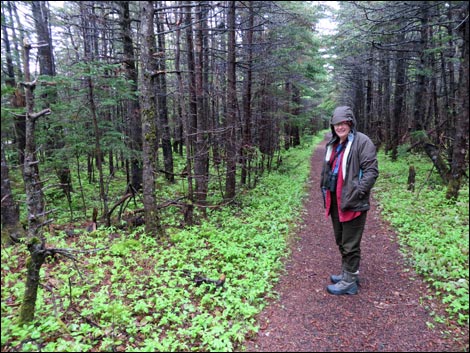 Rain at Gros Morne National Park, Shallow Bay Campground |
Day 30. June 20, 2014. Gros Morne National Park to Notre Dame Provincial Park, Newfoundland We expected a wet day, and we got it. It rained all night, but about dawn, at 3 AM, it calmed a bit, and we made a restroom run. Back in bed with constant rain, we slept late, ate breakfast inside, and finally got out about 10 AM when the rain let up a bit. We went for a damp walk around the campground and actually saw a Gray-cheeked Thrush, plus several White-throated Sparrows and tons of American Robins. We decided to use the rainy day to put on some miles. We stopped at Gros Morne National Park Visitor Center and learned that the trail up Gros Morne Mountain was closed to protect nesting Rock Ptarmigans! We did manage a walk in the rain to a nice waterfall. We drove on towards the East Coast and stopped at Notre Dame Provincial Park. The rain stopped in the late afternoon, so we had a nice evening in camp. We expect more rain by morning. [read more] |
 Walking in the wet woods on a nature trail |
Day 31. June 21, 2014. Notre Dame Provincial Park to Twillingate, Newfoundland We didn't make it very far today, but the miles were all out-of-our-way, so we didn't get too far astray. We awoke to misty skies, but at least it wasn't raining. We walked around the campground and saw a few birds, including a nesting Downy Woodpecker who was feeding large wasps to her kids. People had recommended that we take a short detour to visit a historic site, so we did. Being Canada's National Aboriginal Day, it was appropriate to visit the only known village of the Beothuk people. Interesting, industrious, and clever people, they didn't survive the colonization by European settlers. From there, we couldn't resist driving a bit farther astray to see what Dildo Run Provincial Park was all about. Eating a late lunch there, we decided to continue out towards the end of the road. Arriving in Twillingate in the fog and misty rain, we were greeted by another harbor full of ice bergs. [read more] |
 Walking the Coastal Trail in Terra Nova National Park |
Day 32. June 22, 2014. Twillingate to Lockston Path Provincial Park, Newfoundland Today started out cold. We drove out past Twillingate to Cow Head and the Long Point Lighthouse where, through blowing ice crystals that might have been rain, we looked down the cliffs to vast numbers of ice bergs blown up again the rocky headlands. That took about three minutes, but we drove around Cow Head admiring the views of the icy North Atlantic for a bit longer. We drove inland and stopped in Gander for lunch and groceries, then continued on making two stops in Terra Nova National Park. This isn't the season for birds at the Terra Nova Migratory Bird Sanctuary, but the rain had stopped, so we went for a walk in the woods and saw the long sought Yellow-bellied Flycatcher (LB#627). It is easier when they only have one yellow flycatcher. We also saw Bald Eagle, Osprey, Arctic Tern, and Spotted Sandpiper in summer dress. Continuing onto the Bonavista Peninsula, we stopped for a big dinner, then drove to Lockston Path campground. It is nice here in Newfoundland where $9.75 gets "seniors" a campsite and a shower. [read more] |
 Liz using spotting scope to look at Razorbills and Puffins |
Day 33. June 23, 2014. Lockston Path to Whitbourne, Newfoundland What a day! The morning was warm and dry with few bugs --maybe the bats got them all during the night. Even so, there were few birds, so we broke camp quickly. Driving out, however, we saw a red bird fly across the access road. It was a Purple Finch, and while watching it, we saw several other species -- all in one little area. We then drove to the town of Elliston near the tip of the Bonavista Peninsula and were greeted by courting Common Loons. At the coast, we found a colony of Common Terns who were quite annoyed by the Herring Gull nesting among them. Farther out, we saw 200 Atlantic Puffins, 10 Razorbills (LB#628), 10 Black Guillemots, and 15 Northern Gannets, plus lots of Herring and Black-backed Gulls. We drove out to the old Bonavista lighthouse, which was historically interesting, but other than Black-legged Kittiwakes and Gannets, was a bit of a bust. So with only one more sunny day in the forecast, we left for Witless Bay, stopping in Whitbourne as the sun went down. [read more] |
 A small fraction of the 4 Million birds |
Day 34. June 24, 2014. Tuesday. Whitbourne to Witless Bay, Newfoundland Today was all about the birds -- some 4 million birds breed in the Witless Bay Ecological Reserve, a collection of four offshore islands on the east coast of Newfoundland. For 30 years, Liz and I have dreamt about visiting Newfoundland, and by "Newfoundland" we mean these breeding bird colonies. Thirty years of anticipation did not disappoint. We set out aboard the good ship Atlantic Puffin and soon found a humpback whale. We spent some quality time with the beast, which I must admit was quite cooperative. We made it to Gull Island, one of the four in the reserve. The waters about the island were peppered with puffins and murre, and the sky was filled with countless birds in singles and groups. We were thrilled to be only a few yards from countless numbers of nesting kittiwakes, razorbills, thick-billed and common murre, and of course: puffins! We camped at La Manche Provincial Park, listening to Blue-headed Vireo while Liz cooked dinner. [read more] |
 Jim in St. John's birding at Quidi Vidi Lake |
Day 35. June 25, 2014. Wednesday. Witless Bay to St. John's to Witless Bay (La Manche Provincial Park), Newfoundland We had so much fun that we visited Gull Island again, but this time with Gatherall's Puffins and Whale Watch Tours. The whales cooperated with three humpbacks swimming within 20 yards of Gull Island for 15 minutes. The three whales were grand, and spending the entire trip within a few yards of the island was fantastic. Even more than yesterday, the land, sky, and water was full of birds, literally tens of thousands of birds all at the same time. Afterward, we drove north to St. John's. We enjoyed the history and sights at Signal Hill in gale-force winds, we birded a world-famous birding site (Quidi Vidi Lake), and visited the Fulvarium (fish viewing) just in time for the evening fish feeding. By then, the forecast rain hit, and we drove south to La Manche Provincial Park again, but this time camping in the rain. While taking showers and doing laundry, we heard two or three Boreal Owls calling in the trees so close that we could even hear their chatter calls, but we never saw a one. [read more] |
 Suspension bridge on La Manche Coastal Trail |
Day 36. June 26, 2014. Thursday. Witless Bay (La Manche Provincial Park) to Chance Cove Provincial Park, Newfoundland We awoke to damp, but not rainy, conditions at La Manche, which made the morning dry enough for hot coffee and a bit of birding around the campsite. During breakfast, we heard our Boreal Owls calling again, and the Blue-headed Vireo paid camp a visit. Dry enough for a hike, we walked about a mile to the coast where we visited the site of a small village that was wiped out by a tsunami in 1966. We saw some nice birds, including a Black-throated Green Warbler and a very cooperative Boreal Chickadee. Continuing south, we stopped at a few birding sites and then stopped for a nice lunch in a restaurant with wifi. From there, we continued south to Chance Cove Provincial Park. We are located just over a low ridge from the ocean and can hear the surf, but not so loudly that it muffles the sounds of even more Boreal Owls! In the night, the rain came back. [read more] |
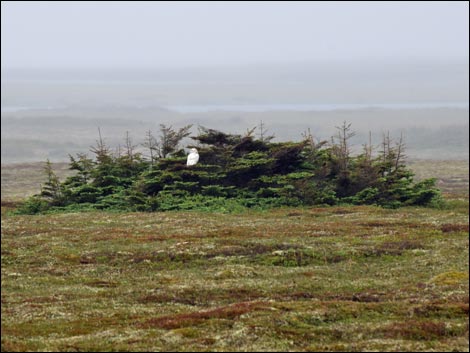 Snowy Owl seeking shelter from the blowing rain |
Day 37. June 27, 2014. Friday. Chance Cove to St. Vincent, Newfoundland We awoke to a wet morning, but the Boreal Owls were calling - the sign of a good day to come! We drove south to Mistaken Point Ecological Reserve, but the fossil site was closed, so we continued on looking for caribou, birds, and a bit of dry. We found neither caribou nor dry, but holy smokes -- did we find the birds! After a few wet stops, we almost skipped Cape Freels because a local said the road was very bad, but we decided to go anyways. Along the road we saw a Snowy Owl (LB#629), and out at the cape in the driving rain, we saw lots of gannets and kittiwakes, plus a juvenile Iceland Gull (LB#630). Heading back to the highway, we stopped to visit our white friend again, then a few miles along, Liz spotted another Snowy Owl! So not only did we finally see one Snowy Owl, we saw two! We finished the day at St. Vincent Beach, staying at the Whale Song B&B where we can dry out before heading to Cape St. Mary's tomorrow. [read more] |
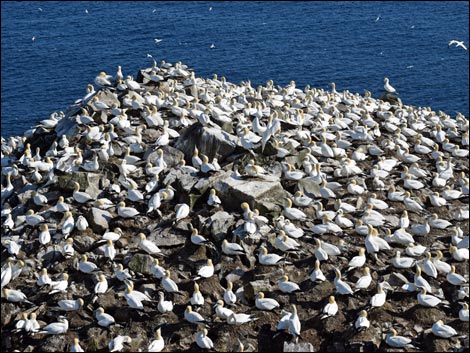 A few of thousands of nesting Northern Gannets |
Day 38. June 28, 2014. Saturday. St. Vincent to St. Bride's (Cape St. Mary's), Newfoundland After sleeping in a bit, we awoke to a breezy but dry day. Great things lie ahead on our journey today. We left the B&B and headed for St. Vincent Beach where we found about 25 nesting Arctic Terns, five Humpback Whales, and 200 Northern Gannets. What a way to start a sunny day. From there, we drove to Cape St. Mary's, which is the highpoint of sea-bird birding on this trip. The gannet colony is so big and so noisy that we could hear them from the parking lot, a mile from the nest cliffs! We could smell it from there too. In addition to gannets, we saw nesting Common Murre, Thick-billed Murre, and Black-legged Kittiwakes, plus we finally saw Great Cormorant (LB#631). Overall, it was everything we had anticipated for the last 30 years. We camped in what passes for a private RV campground near St. Bride's, about 12 miles from the nesting birds. |
 Bird Rock -- We've looked forward to this for 30 years! |
Day 39. June 29, 2014. Sunday. St. Bride's, Newfoundland. What an amazing day! Cape St. Mary's Ecological Reserve: nowhere else on earth can you get so close to so many nesting birds without disturbing them. During the breeding season, some 24,000 Northern Gannets, 20,000 Black-legged Kittiwake, 20,000 Common Murre, and 2,000 Thick-billed Murre, more than 100 pairs of Razorbills, more than 60 pairs of Black Guillemot, plus a few Double-crested Cormorants and Great Cormorants come here to nest and feed on the rich fish supply. The Fin Whales, Minke Whales, and Humpback Whales, Gray Seals, and Harbor Seals come to feed here too. In addition to birds on the cliffs, the sea surface is covered with vast numbers of birds, literally, for as far as the spotting scope can see. Most of the gannets nest on Bird Rock — a 300-ft-tall rock spire that is separated from the viewing area by a chasm only a few yards wide. The gannets' courtship, nesting, and feeding behaviors, interactions, and delicate flying maneuverer over the crowded rock spire are endlessly fascinating and easily observed from the edge. Being so close, not only is the experience a visual assault on your eyes, it is a loud and smelly assault on your ears and nose too! [read more] |
 Aboard ship with Newfoundland fading into the background |
Day 40. June 30, 2014. Monday. St. Bride's to the Labrador Sea. We left the B&B and stopped at Cape Verde where we walked on the beach; spotted some 20,000 Sooty Shearwaters, a few gannets, and one Great Shearwater (LB#632); and generally reminisced about our time in Newfoundland. We are sad to be leaving. Before catching the 5 PM ferry, we needed to get groceries and sort out gear. There was a festival in the grocery store parking lot, and with a local band entertaining, we listened to local ballads and packed. Aboard ship, we looked for seabirds in the cold wind, spotted a few dozen Sooty Shearwaters and Great Shearwaters, and even saw several Manx Shearwaters (LB#633). Jim birded until dark, about 10 PM. The ferry runs overnight and takes 13-15 hours depending on conditions, so tonight we are camping aboard ship in the Labrador Sea. [read more] |
 Early morning birding in the middle of the Labrador Sea |
Day 41. July 01, 2014. Tuesday. Labrador Sea to Cape Breton Highlands National Park, Broad Cove Campground, Nova Scotia Today is Canada Day, a celebration similar to the US Fourth of July, but for us, it was just another day of great birding. Jim was up and out at first light (about 5 AM). The early morning birding was great as the ship passed through flocks of Great Shearwaters roosting on the water, waking them up, and taking them by surprise. Passing close to the ship, many of the shearwaters put their heads in the water as if to hide like an ostrich with its head in the sand. We also saw more Sooty and Manx Shearwaters, plus Northern Fulmar and both species of storm-petrels. The ferry arrived in North Sidney, Nova Scotia, about 10:15 AM, and from there we drove north about 3 hours to Cape Breton Highlands National Park. We found a nice campsite, but the day is too warm (about 86 degrees) to sleep in the van, so we setup the tent to keep off the bugs and possible afternoon thunder showers. It will be early to dinner and early to bed, missing unfortunately, the Canada Day fireworks here in the national park. |
 Liz visiting with her plant-friends in a fen-bog |
Day 42. July 02, 2014. Wednesday. Broad Cove Campground to Cheticamp Campground, Cape Breton Highlands National Park, Nova Scotia We did a lot of walking and some driving on this 2nd very hot day. We slept a late to make up for not sleeping much on the ferry, then spent some time walking near camp. From there, we hiked about halfway up Franey Mountain looking for Bay-breasted Warblers. We heard about five (LB#634; heard only), but never saw a one for sure. We drove north around the tip of Nova Scotia, stopping several times to see the sights and look for birds. When the road turned up into the highlands (to about 1,500 ft), we walked on a trail among 250-year-old sugar maple trees and on a boardwalk through a fen-bog where Liz got to spend quality time with some of her old friends and some new ones too. We found two species of blooming orchids, pitcher plants blooming, and even some sundews. We got a quiet site in Cheticamp Campground where it was so hot that we had to sleep in the tent. [read more] |
 Liz on Benjie Lake Trail in Bicknell's Thrush habitat |
Day 43. July 03, 2014. Thursday. Cheticamp Campground, Cape Breton Highlands National Park, Nova Scotia When traveling at your whim without a schedule and seemingly without a time limit, it can be funny how things work out. Long story short: we saw a brochure about super-rare Bicknell's Thrushes in the park, drove back, walked about 200 yards up a trail, and started hearing 2-3 birds singing (LB#635; heard only)! We walked the rest of the 1-mile trail to the lake and saw two pairs of Mourning Warblers and moose scat and tracks. We then went across the road for another nice, long tour of the fen-bog, and finally relaxed in the shade for a couple of hours waiting for the thrushes to start their evening songs. Towards sunset, we walked back up the trail and heard the thrushes again, but the wind was down, and we could hear them much better. We also saw a very pretty male Magnolia Warbler. Straggling in after dark, we turned 7,000 miles on the trip as we returned to Cheticamp Campground for a second night. [read more] |
 Liz visiting a working sheep ranch (here in the barn) |
Day 44. July 04, 2014. Friday. Cheticamp Campground to Tatamagouche, Nova Scotia. Celebrate USA Day; it was interesting to note that we saw not a single tip-of-the-hat to America on her birthday. We awoke to a beautiful day (sunny with light breezes -- truly the lull before the storm) and spent time relaxing in camp and birding the area. Heading west, we stopped for lunch and at a working sheep ranch where they do real "living history" taking wool from sheep, spinning it, and producing goods. We then continued west to Tatamagouche where we got a room at the Balmoral Hotel to wait out Hurricane Arthur, which should affect this area tomorrow. After checking in, we continued to Wallace Bay National Wildlife Area for a bit of evening birding. We returned to town, got dinner in a nice chowder house, and retired to the hotel for the night. The leading edge of the storm is upon us, but the winds still are pretty light and we remain dry. [read more] |
 Looking out on the storm -- wind, but not too much rain so far |
Day 45. July 05, 2014. Saturday. Tatamagouche, Nova Scotia. Waiting out the storm, we are relaxing in the Balmoral Hotel where they offer free wifi, breakfast, washing machines, and international telephone calls. Liz is knitting and I am backing up photos, GPS, and voice data. It seems that after 45 days on the road, we are taking a well-deserved vacation from vacation. During the morning, we had strong winds and some heavy rain, but mostly moderate winds and light rain. The TV reports that some areas around us have lost power. Later, we remained dry, but with extreme winds. This was a good day to be off the roads. |
 Looking at fish and birds in the Wentworth River |
Day 46. July 06, 2014. Sunday. Tatamagouche to Amherst, Nova Scotia. After weaving among downed trees and getting past power company workers rebuilding powerlines after the hurricane, we birded the Wallace Bay area again. It was windy and the birding wasn't great, but we had a really nice time. We drove to Wentworth Provincial Park. Again, the birding wasn't great, but we did see a Chestnut-sided Warbler. At the Joggins Fossil Beds on the shore of the Bay of Fundy, we arrived too late in the day to visit the fossil beds, but the museum was quite interesting. We will return tomorrow. With the Bay-of-Fundy tide coming in, we went to a tidal-bore viewing site hoping to see a wall of water come rolling up the bay, but we saw barely a ripple. We found another place where we can watch again tomorrow. Late in the day, we drove to downtown Amherst and got a room. [read more] |
 Liz holding cast of 300 million-year-old tree root at Joggins Cliffs |
Day 47. July 07, 2014. Monday. Amherst, Nova Scotia. Some days are about birds, some days are about driving a long way, and some days are about plant fossils -- this was one of those days. We started the day birding the Amherst Marsh under cloudy and windy conditions, but we did see Black Tern, American Bittern, and Purple Martin. We returned to the hotel for lunch, then went birding at the Amherst Point Bird Sanctuary. We only had an hour, but the birding had promise and we will return tomorrow morning. We then went back to Joggins for the 2-hour tour. We were led by a young geologist who was a good leader and really knew her stuff. We saw three species of extinct trees, seed ferns, and the remains and tracks of fish and invertebrate species. Late in the day, we stopped at a tidal-bore viewing spot and saw a 4- to 6-inch-high tidal-bore. Not the raging rapid we hoped to see, but a tidal bore nonetheless. From there, we returned to the Victorian Motel. [read more] |
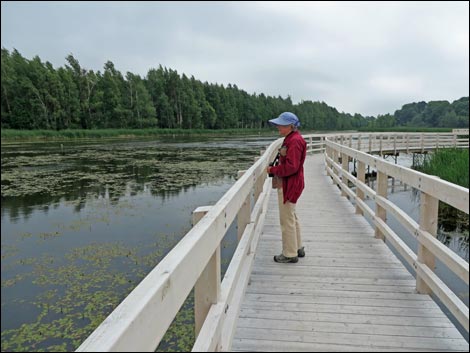 Sackville Waterfowl Park |
Day 48. July 08, 2014. Tuesday. Amherst, Nova Scotia to Moncton, New Brunswick We had planned to bird the Amherst Point Bird Sanctuary again, but amid swarms of mosquitoes and persistent rain, we gave up and spent a few minutes in downtown Amherst before heading west. We crossed into New Brunswick and stopped at the Sackville Waterfowl Park, a community-run birdwatching site much like the Henderson BVP at home. The visitor center was staffed, and the trails and boardwalk were in perfect conditions. We spent several hours there, seeing Mute Swan, lots of baby ducks, and finally seeing a Sora, which have been calling to us, but hiding, for weeks. Still arguing with the Bay of Fundy and its tidal bores, we decided to stop short for the night and get a room overlooking what is said to be one of the two best places to see the bore: the Moncton Waterfront. We are expecting an 18-in tidal bore this evening. But damn, it arrived 20 minutes early and we missed it by about 1 minute. We could see it moving upstream beyond us. [read more] |
 The "flower pots" at Hopewell Cliffs Provincial Park |
Day 49. July 09, 2014. Wednesday. Moncton, New Brunswick to Fundy National Park, New Brunswick We finally saw the tidal-bore, and it was worth the effort. It was due at 7:38 AM and got out about 7:00 AM. We enjoyed some morning coffee on the boardwalk, and when the waves rounded the corner early, we were there to watch the whole thing. We stopped at Hopewell Cliffs Provincial Park. This is an area of oddly eroded conglomerate rocks that leaves arches and short sea-stacks with trees growing on the top. At high tide the area is flooded, but at low tide, hordes of humans swarm the ocean bottom for a look up at the rocks. From there, we headed south and got a campsite at Fundy National Park, Chignecto Campground. We have a chilly wind here that should make for good sleeping. We also have a pesky Red Squirrel who is getting onto the van and everything. [read more] |
 Look -- there's a Nelson's Sparrow out in the grass and fog! |
Day 50. July 10, 2014. Thursday. Fundy National Park, New Brunswick Today we didn't do much, but we sure had a good time taking all day to do it. We started out towards Mary's Point, the famous birding spot back up the coast, but were distracted by Nelson's Sparrows (LB#636) in a salt marsh along the way and then by Cape Enrage. Reported to be the best view in all of New Brunswick, and we couldn't see it in the dense fog -- we were enraged! We finally got to Cape Mary's as the fog was lifting. By the time we walked down to the beach, the sun had come out and it was bright and sunny. We had a fun walk with lots of birds in the trees (Purple Finch, Common Yellowthroat), but as we expected, the hoards of shorebirds had not yet arrived. Even so, a walk on a sandy beach on the shore of the Bay of Fundy watching the tide race out was a treat, a windy treat, but a treat nonetheless. Back in Chignecto Campground, Liz fixed pork chops for dinner! [read more] |
 Hiking in Fundy National Park |
Day 51. July 11, 2014. Friday. Fundy National Park to Pocologan, New Brunswick Up and out fairly early, we did two hikes in Fundy National Park. The first hike was in the woods for about 2-3 miles. We had fun chasing the sounds of warblers and had a nice look at a Red Fox. The second hike was about 0.3 miles on a boardwalk in a marshy area. The birds were pretty quiet, but we saw some really pretty, black-winged damselflies. We left Fundy National Park and headed south. We stopped in Hampton at a little marsh that at first seemed pretty bleak, but we ended up chasing more warblers and having a good time. The last stop was a park on the south side of Saint John with forest and salt marsh. We walked some in the woods, checked some tide pools in the Bay of Fundy, and walked on a boardwalk in a salt marsh. We continued south and stopped in Pocologan, a little town on the edge of the sea just north of the Canada-US border. [read more] |
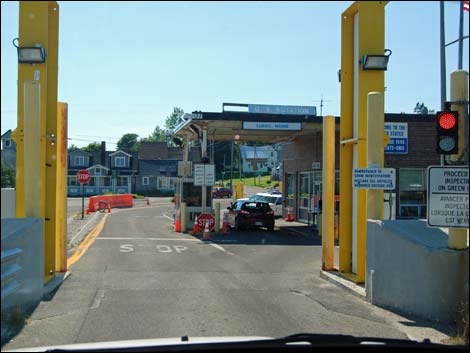 Crossing the border into the US |
Day 52. July 12, 2014. Saturday. Pocologan, New Brunswick, to Ellsworth, Maine, USA Back in the US, back in the US, back in the USA! We island hopped across southeast New Brunswick (two ferries) visiting Deer Island and Campobello Island. On Deer Island, we ate breakfast at the 45th Parallel Restaurant. Tasty fish and chips. On Campobello Island, we had an interesting visit at the Roosevelt Campobello International Park, the summer home for many years of Franklin D. Roosevelt, and now a joint US-Canadian National Park. From there, we crossed back into the USA at Lubec, Maine, and then visited Quoddy Head State Park, the eastern-most point in the US. A bit farther south, we visited Maine Coastal Islands National Wildlife Refuge, Petit Manan Unit, and walked the 1.5-mile Hollingsworth Trail near sunset. The woods were full of singing Hermit Thrushes. Driving towards Acadia National Park in the dark, we stopped at a hotel in Ellsworth, Maine, for the night. [read more] |
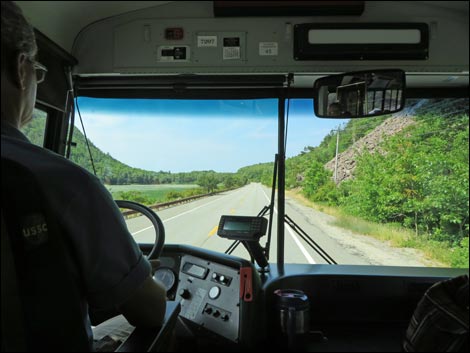 Riding the shuttle bus in Acadia National Park |
Day 53. July 13, 2014. Sunday. Ellsworth to Acadia National Park, Black Woods Campground, Maine Today was a funny day. We slept late, got out of the hotel at a relaxing pace, and then decided to do laundry before heading to the campground for three days. We found that the laundry was along fast-food alley, so ate junk for breakfast (we really are back in the USA!) and realized that there was an L.L. Bean Outlet Store across the street. We couldn't pass that up. We tried to call Heather Rice, an old friend from our Sequoia National Park rangering days (mid-1980s), but all we got was voice mail. We drove into Acadia National Park and got a site in the campground, which will be full tonight. We rode the park shuttle bus into Bar Harbor town, and while walking around, we saw Heather driving a tour bus. We caught her at the end of her route and chatted for 30 minutes, making plans to do some hiking tomorrow. We rode the shuttle into town, walked around a bit, then caught the wrong bus and spent two hours trying to get back, only to find that the bus system was messed up and had to wait 1-1/2 hours for a 10 minute bus ride to the campground. [read more] |
 |
Day 54. July 14, 2014. Monday. Acadia National Park, Maine It rained a bit in the night, but to our surprise, the ground, tent, and everything was mostly dry when we got up. We spent the day with Heather hiking and sightseeing in the park. We got to Heather's House about 9 AM and enjoyed tea and hot, fresh-baked cookies, then walked out the back of her property into the woods of Acadia National Park. We hiked several miles on "carriage trails" that were built for horse-drawn carriages in the early 1900s. After the hike, Heather drove us to the top of Cadillac Mountain in her "topless" car. It was a treat to be chauffeured around in a convertible where we could look up at the trees and blue sky. On the way down, we stopped for an elegant lunch and traditional "tea and popovers" on the lawn overlooking Jordan Pond. Back in camp, Liz fixed another nice dinner as we prepare to move out in the morning and head down the coast. |
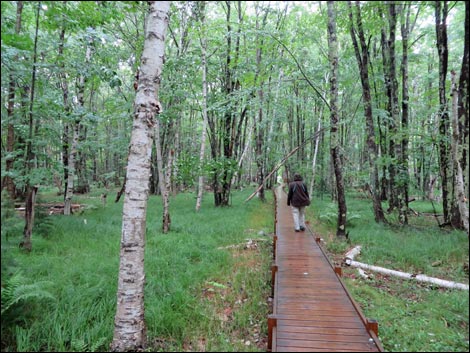 A wet walk at Acadia National Park |
Day 55. July 15, 2014. Tuesday. Acadia National Park to Freeport, Maine We awoke to another foggy, but not wet morning, and thinking that again we'd not get rain, we decided to attend a bird walk led by a park ranger. About 7:05, just as the bird walk was getting started, the rain hit. We fought it for a few minutes, but the ranger took us inside the nature center hoping that the rain would stop. It never did, and after an hour, he canceled the rest of the walk. Liz and I tried to press on, but wet and getting cold, we too left defeated. We rode the park bus for an hour to see some areas we'd missed and to dry out, then tried a bit more birding. Again, we got wet and decided to give it up and leave the park. Heading out in rain and heavy fog, we drove through another area of the park we'd missed, then continued south on the blue roads. The rain came and went, but at least the fog lifted. We made it to Freeport, Maine, just before heavy rain and lightning started; there were even two tornadoes just north of us. We were glad to be off the roads. |
 Looking for Saltmarsh Sparrows in Scarborough Marsh |
Day 56. July 16, 2014. Wednesday. Freeport to Boston, Massachusetts We got up and out fairly early because it wasn't raining and stopped between rain squalls at an Audubon preserve. We had a nice, but damp, time birding the site. We saw a hen turkey with 8-9 1/3-grown chicks, the first House Wren of the trip, a woodchuck, and even the first of the south-bound migrating shorebirds (Least Sandpipers). From there, we continued south to Scarborough Marsh where we hoped to see Saltmarsh Sparrows. Sure enough, we drove up, looked out, and saw a Saltmarsh Sparrow (LB#637) about 10 feet from us! Between rain squalls, we saw several others, but the first was the closest. We continued south and stopped briefly at Rachel Carson National Wildlife Refuge. The birds were pretty quiet, but it was getting late on a wet and rainy day. From there, we blasted south through New Hampshire and into Massachusetts, arriving in Boston about 6 PM to stay with Kathy and Chris for a couple of nights. [read more] |
 Walking on the Whipple Trail |
Day 57. July 17, 2014. Thursday. Boston As the storm passed during the night, a cold air mass moved in bringing a delightfully cool, sunny morning. While lying in bed, the morning birdsongs brought memories of Carolina Chickadee and Red-bellied Woodpeckers, but surely those were memories from Florida, not Boston. Well, although the books don't show them here, the calls of those two species are, in fact, well-seared in my brain and it was fun to hear them again. After breakfast, we walked a nearby trail that led quickly to the highest point on the hills surrounding Boston. We picked blueberries for a cake and saw Downy Woodpeckers, White-breasted Nuthatches, and even Blue Jays. In the afternoon, we hiked another local park. The birding was pretty much of a bust from what we expected, but it was a nice, 3-mile walk. We did see 20 species of birds, including a Canada Goose with band number 1048-99586, which we reported to the US Fish and Wildlife Service. [read more] |
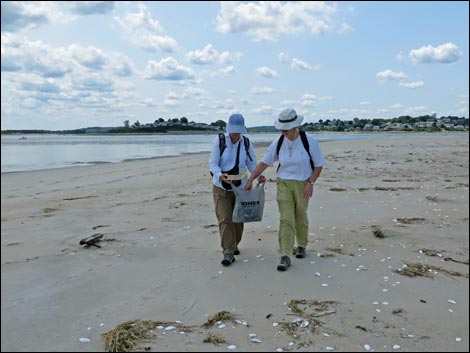 Kathy and Liz cleaning up the beach at Sand Point |
Day 58. July 18, 2014. Friday. Boston Chris and Ben left early to catch a flight to Montana for a week of hiking, and we spent the day with Kathy. We three headed north to the coast where we walked on the beach and birded at Parker River National Wildlife Refuge, about an hour north of Boston. Parker River NWR is like a barrier island, but is actually a long, narrow peninsula with ocean on one side and river marsh on the other. We spent most of the day at Sandy Point State Reservation (like a state park) -- the tip of the peninsula. Out there, we saw Piping Plovers with their kids, Bank Swallow nests, and lots of Least Terns feeding in the river and carrying fish to their puff-ball nestlings. The tern colony is fenced off to keep people out, but walking along the fence, they come out to drive you off, and that was fun. We stopped to bird the river marsh and saw lots of shorebirds (e.g., Black-bellied Plover, American Avocet, Short-billed Dowitcher, Greater Yellowlegs) who are just now starting to migrate south. Back in Boston, we went out to dinner at an Indian restaurant where the food was very tasty. |
 One of several ponds along the way |
Day 59. July 19, 2014. Saturday. Boston to Glen's Falls, NY We relaxed chatting with Kathy, then departed about 10 AM. We first went for a short walk in a local park that turned out to be pretty good for birds, which it turns out, was the best for the day. Hitting the road for the first time westward and heading more-or-less for home, we drove backroads across Massachusetts and up into New Hampshire, then west across southern Vermont. We stopped several times to bird, but other than stretching our legs, our stops weren't very productive. We did see Mute Swans, a Green Heron, lots of Bank Swallows, Wood Ducks, lots of Gray Catbirds, and a Red-shouldered Hawk. It was interesting to see the gritty underbelly of New England. We stopped at the Southern Vermont Natural History Museum, an interesting place with hundreds of stuffed birds collected in the 1900-1920 time frame, including a Passenger Pigeon. They also had several live hawks and owls on display that they use in education. We ended the day on the edge of the Adirondack Mountains. This area is very crowded at this time of year, but we found a dumpy, low-end, and expensive place to spend the night in Glen's Falls. |
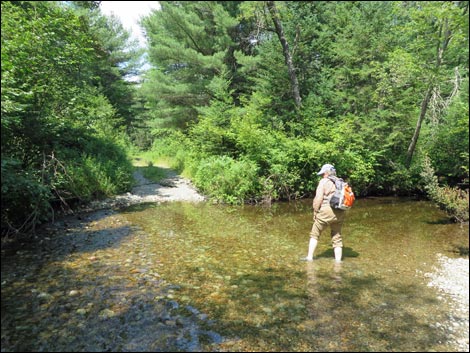 Wading creek on Dix Mtn. Wilderness access road |
Day 60. July 20, 2014. Sunday. Glen's Falls to Lake Placid, NY We left the hotel fairly early, got breakfast to go, and stopped at a French and Indian War (Seven Years War) battle site to eat and watch birds. The 1750s site was interesting, but the birds didn't cooperate very much. Driving north into Adirondack Park, we were somewhat surprised by the hordes of people and the amount of low-end development along the highway. I guess they've had since the 1760s to build wall-to-wall traveler services, and some of it is showing its age. We stopped at an unlikely spot, the narrow dirt access-road to Dix Mtn. Wilderness, and found a delightful place to bird. We saw Black-throated Blue Warblers, Black-throated Green Warblers, Chestnut-sided Warblers, Magnolia Warblers, Nashville Warblers, Ruffed Grouse, Least Flycatchers, plenty of other bird species, and a little shrew. Burned by the lodging last night, we stopped early at a New York State Campground (Meadowbrook). This isn't wilderness, but at least we can walk next door and get BBQ for dinner and then across the street to an ice cream shop. Later, we'll walk across the railroad tracks and up a trail towards a mountain summit looking for higher elevation birds. |
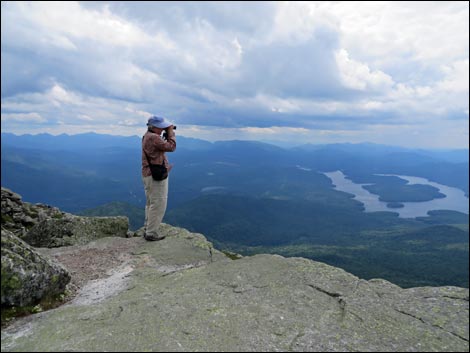 Birding atop Whiteface Mountain; Lake Placid in the background |
Day 61. July 21, 2014. Monday. Lake Placid, NY We spent the day birding and sightseeing in the Adirondack Mountains. We started out birding some lowland sites, then got a campsite about noon at Wilmington Notch (a few miles northeast of last night). From there, we headed for higher elevations and spent most of the day on Whiteface Mountain. The birding wasn't great, but the changing habitats from the bottom to the summit was interesting over so short a distance. We listened for Bicknell's Thrush, but without success, as this is one of their prime breeding locations in the United States. We were delighted, however, by a juvenile Peregrine Falcon hunting and playing around the summit. In camp, we were alerted by the shrieking of hungry little falcons to the presence of a Bald Eagle soaring down the canyon. Of course, that brought our attention to a nest with three Merlin kids and their parents in a tree in the campground. [read more] |
 One last walk in the northeastern hardwood forest |
Day 62. July 22, 2014. Tuesday. Lake Placid to Syracuse, NY The morning dawned clear and cool, a delightful change from the last few days. During breakfast, we heard the Merlins squawking over their breakfast, and after we finished eating, we went over to see them. The parents were out hunting, but the kids were playing on the ground. It was fun watching them running around and jumping on little things on the ground (e.g., bark and pine cones). We also got some great video of one fledgling. The ground under the trees was littered with bird scraps dropped by the fledglings. Leaving camp, we drove through Lake Placid, proper, and continued northwest to just north of Paul Smith's College (a town) and hiked in the woods at the Visitor Information Center. The hike was fairly long, the day was fairly hot and humid, and the birds were nearly silent. By the end of the hike, we had the feeling that the birds were done, we were done, and it was time to start home. We hit the highway and then the west-bound Interstate, making it to Syracuse before it got too late. |
 Niagara Falls: American Falls (view from the Canadian side) |
Day 63. July 23, 2014. Wednesday. Syracuse, NY, to Niagara Falls (2.5 hours driving), to London, Ontario, Canada (2 hours driving) Up and out early, we drove to Niagara Falls, New York, in sometimes torrential rain where even the locals slowed down on the interstate. The rain stopped about the time we hit Niagara Falls town. We visited Niagara Falls State Park on the American side of the river, then walked across the bridge to the Canadian side. We wanted to see the "other" side because they say the view is better from Canada, and yes, they are correct. We walked back to the American side, retrieved our van, and drove back across the same bridge. After a long wait in traffic, we cleared customs quickly. In Canada, we drove west across southern Ontario to London. We crossed a number of long bridges, but I don't recall crossing the Atlantic! [read more] |
 Jim at Point Pelee, southern-most point in Canada |
Day 64. July 24, 2014. Thursday. London to Findlay, OH We birded the Westminster Ponds, a nice natural area near the hotel in London. Leaving Canada on a high note. Drove to Point Pelee National Park on the north side of Lake Erie (Canada). Not the right time of year, but lots of birds. Crossed back into the US. Got a grumpy border guard, but we made it with little time lost. Drove to Magee Marsh Wildlife Area on the south side of the lake (USA). Birded the half-hour before sunset. Not what we expected, but a nice place. Saw a Little Gull (LB 639) at sunset. Continued late into the night (construction delays on Interstate 75), stopping at Findlay, Ohio, around 11 PM. |
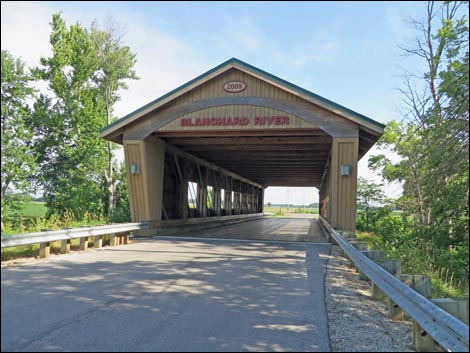 Blanchard River covered bridge |
Day 65. July 25, 2014. Friday. Findlay to Horse Cave, KY We birded Blanchard River "Riverbend" Park on the outskirts of Findlay in the morning. The morning was beautiful, but the birding wasn't what we'd hoped. We did see Indigo Buntings, several House Wrens, and an adult Bald Eagle, all of which are always a treat to see. We then hit the highway for what seemed like a hard day. The traffic was fairly heavy the entire way, there were several construction delays and detours, we passed through several large cities, and we did about 400 miles. At about 4:30 PM, now Central Time, we arrived at Mammoth Cave National Park and got a reservation for the earliest 2-hour cave tour tomorrow morning (unlike Carlsbad Caverns where visitors can do self-guided, self-paced tours, around here they do the civilized thing and make you go in a group with a guide for a price). We saw the Visitor Center so that we don't need to spend more time in the morning. We found a low-end motel room in Horse Cave and made up for that by enjoying a surprisingly good Mexican dinner in Cave City. |
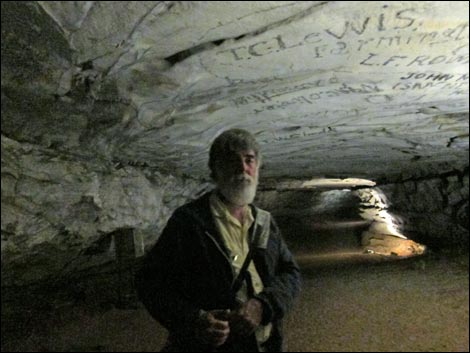 Jim inside Mammoth Cave |
Day 66. July 26, 2014. Saturday. Horse Cave to Little Rock, AR We got up and out of the hotel early, arriving at the appointed place near the mouth of Mammoth Cave with plenty of time. We did the 2-hour "Historic" tour of the cave with a very interesting park ranger: Jerry Branford. His great-grandfather, Matthew Branford, was a slave and one of the two original cave tour-guides; the other was his uncle. We might say that Ranger Jerry had an interesting perspective on the cave and told some great stories. After touring Mammoth Cave, we drove all day, 480 miles, arriving in Little Rock, AR, late in the day. At a gas station, we asked about any nearby Southern BBQ restaurants. We were directed to Jordan's BBQ and Catfish, which turned out to have great food. Too full to drive farther, we stopped at the nearest hotel for the night. |
 Brother Bill's house in Dallas, TX |
Day 67. July 27, 2014. Sunday. Little Rock to Bedford, TX We drove without stopping (at least not for fun) all the way to Bedford, arriving early-afternoon. We spent the day with Bill, Maria, and the two kids. Bill fixed a nice Texas dinner on the grill. After dinner, Billy departed en route to Texas A&M where he is in his second year. |
 Barreras Mexican Restaurant has wonderful food |
Day 68. July 28, 2014. Monday. Dallas to Amarillo, TX After a nice morning visiting with Bill and Maria, with Catherine coming and going, we departed Dallas early-afternoon. Initially, the driving was awful, but as we headed northwest, the roads got better, and the traffic got lighter. We drove through a rainstorm, but the worst of it passed quickly. We drove about 350 miles, stopping briefly for a snack and again for dinner. We were looking for local-color Mexican food, and we found it in Claude, TX, at a wonderful little restaurant: Barreras Mexican Restaurant. The food was authentic and tasty, and the owner's granddaughter kept us entertained. We made it to Amarillo where we found a plethora of motels all competing for the traveler's dollar. Contrary to our usual behavior, we chose a mid-priced place. Unfortunately, I think we would have done better at either end of the cost spectrum. I won't mention the name because, as they say, any advertising is good advertising. |
 Bill and Liz in Albuquerque |
Day 69. July 29, 2014. Tuesday. Amarillo to Albuquerque, NM We departed the hotel early and with breakfast, better feelings about the place than we did last night. It was very annoying that the keys didn't work all the time, but we got through it. The highway was fairly clear and in good condition, but we did encounter some extremely heavy rain and lightning. It was nice to follow an 18-wheeler through the storm at 40 mph (75-mph zone) while many other drivers pulled off the highway onto the shoulder. We stopped at the two rest areas we visited on the way east. One was very quiet and would never have attracted our attention, but the other was still full of Western Kingbirds and Lark Sparrows, plus House Finches, Northern Mockingbirds, and even a Bullock's Oriole. We arrived in Albuquerque by lunch and have been visiting with Liz's brother and his wife, Bill and Karen LaRue. It is always nice to visit with family and catch up on the news. |
 Liz on trail at Petrified Forest National Park |
Day 70. July 30, 2014. Wednesday. Albuquerque to Holbrook, AZ We departed Albuquerque after breakfast heading west and drove a total of about 270 miles. We stopped at Petrified Forest National Park to visit some of our favorite petroglyph sites. At the old Petrified Forest Inn, we stopped to visit the nearly life-sized mountain lion petroglyph that they have on display. We then drove to the Puerco Pueblo ruin to see the "White-faced Ibis eating a frog" petroglyph. There are some other nice glyphs at this site. We then drove to the south end of the park and cooled off inside the museum. We even watched the video to spend a few more minutes inside. From there, we set out on a 3-mile hike in the hot sun to see an Indian ruin site made of petrified wood rather than old stones or mud bricks, and to see some of the longest petrified logs on earth. This area was amazing, as some places were 100% covered by petrified wood logs and petrified wood fragments. We didn't see many birds today, but we had a good time, partially because we saw two species of spiny lizard, whiptail lizards, and earless lizards, plus a cooperative Prairie Falcon who allowed close photographs (well, close for a falcon anyways). |
 Safely, home again |
Day 71. July 31, 2014. Thursday. Holbrook to Las Vegas, NV. (5.5 hours, 350 miles) Today we are going home ... but not too quickly. First, we had a nice breakfast at the hotel restaurant, then we stopped to bird the Holbrook Waste Water Treatment Ponds (a wetlands area). Driving on, we stopped in Flagstaff and did a short hike to a wetland to do a bit more birding. Finally, we hit the road for a final time, driving west through torrential downpours (Liz got lightning in a photo), we topped off the gas tank with cheap Arizona gasoline and drove home. We were gone a long time. We saw some great places. We saw some great birds. We saw some great people. It is nice to be home. |
Note: All distances, elevations, and other facts are approximate.
![]() ; Last updated 190104
; Last updated 190104
| Postcards | Trip Map | Copyright, Conditions, Disclaimer | Home |